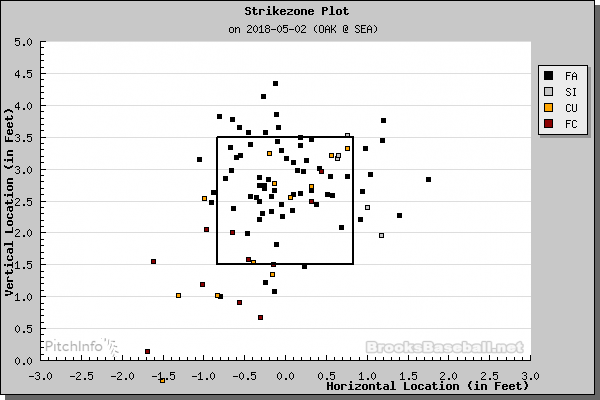Something Just Clicked
In yesterday’s post about James Paxton’s spin rate improvements, I said that while he’s been pretty good, “he just hasn’t gone nova the way [Gerrit] Cole has,” and that he may need to learn to utilize his fastball differently as its shape and movement change. Hours later, he went out and did exactly that, and the results were extraordinary.
Gerrit Cole’s fastball not only started spinning more when he joined the Astros, but he started throwing it higher. His average fastball elevation with the Pirates was dead on the middle of the strikezone; he clearly liked to throw some low fastballs that were so beloved of his old pitching coach, Ray Searage. But with Houston, that average fastball elevation was 0.2 feet above the midpoint of the zone. Paxton’s fastball had seen even *more* dramatic spin improvements, but as I wrote yesterday, he still liked to throw it down in the zone. It had an average height a few inches below the zone in 2016, and it did in 2018, too.
Until last night. Paxton’s average FB height was 0.3 feet above the center of the zone, and he used a blizzard of high fastballs to utterly dominate a good hitting team in Oakland. Sure, the A’s have plenty of swing and miss in their line-up, and yes, Paxton’s command of the pitch had a lot to do with his stunning performance, but it was amazing to see how an adjustment in approach could produce such immediate dividends. I said yesterday that if he fully incorporated his new spin into his approach, look out league. It looks like he may have done so. Good luck, AL.
This isn’t to say that he’s already the best pitcher in the league. He essentially beat the A’s with 1 pitch, or maybe 1.5. His cutter worked well as a pitch that moved lower in the zone, and it allowed him to get called strikes and whiffs as batters got used to to the rise on his fastball. More worrying, even during a career-best, career-defining performance like this, his curveball is still lagging behind. The A’s recognized it and put some good swings on it, and he only threw it 12-13 times. It *should* be more of a weapon, but it hasn’t been this year, and wasn’t last night. That’s both a thing to work on, and a testament to what Paxton’s fastball can be when it’s on like that: it can be so dominant that Oakland looked helpless against it even when they knew it was coming.
Fastballs with a lot of rise at the top of the zone become whiffs. Fastballs with a lot of rise near the bottom of the zone don’t turn into whiffs *or* ground balls. As Paxton’s seen, they actively help batters elevate the ball. It’s why Paxton’s expected wOBA on fastballs was nothing special coming into last night’s game, and why the pitch looked completely different once he started pitching up. Even last night, A’s hitters went 2-3 on fastballs below the midpoint of the zone. On fastballs above that point, they were 1-15. There’s a lesson here.


The first seven innings of last night’s game were some of the most memorable I’ve seen in quite a while. Big Maple was awesome.